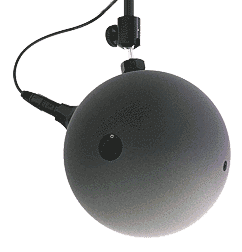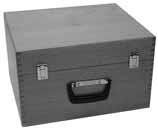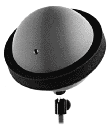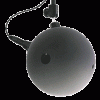Opis
- head-related stereo microphone for loudspeaker reproduction
- very good imaging and sense of depth; natural localization, very natural sound
- with qualities of a dummy head when headphones are used for listening
- natural sound with superior low-frequency performance
- for phantom powering (12 V or 48 V)
The KFM 6 sphere microphone is the embodiment of a stereo microphone design using an acoustic baffle. It bears some resemblance to a “dummy head“ and follows some of the same principles – but while dummy head recordings can provide excellent results, they are suitable only for headphone listening. The “Sphere“ microphone was developed so that similarly convincing results could be achieved for loudspeaker playback. To fulfill this objective the microphone must provide not only interaural arrival-time cues, but also spectral-vs-angular incidence information. A further requirement was that the frequency response on the main axis of the microphone in the free sound field and also the frequency response in the diffuse sound field remain flat. (See G. Theile: “On the naturalness of two-channel stereo sound,” AES/SMPTE Joint Television Conference, Jan. 1991, Detroit)
Accesories (included):
- HKFM, a universal device for suspending the KFM 6 on lines
- KG, ball-and-socket joint for mounting the KFM 6 on a stand
- AK SU/2U, adapter cable (XLR-5F to 2 × XLR-3M)
Accessories (optional)
- KKFM, wooden shipping case for the KFM 6 and accessories such as the mounting and suspension devices, other hardware etc. Dimen
- WKFM, a foam windscreen for outdoor use in moderate wind. It has minimal effect on the sound pickup (diam. 200 / 240 mm x 40 mm
- XLR-5 stereo cables
In constructing the KFM 6, two special pressure transducers are mounted flush on the surface of a sphere 20 cm in diameter, an acoustic baffle having especially favorable properties.
Normally two pressure transducers placed so close to each other would not provide a convincing stereo image. However, the sphere between the capsules creates a frequency-dependent emphasis of level differences comparable to that which occurs naturally between the human ears.
The frequency response on the stereo main axis of the KFM 6 is flat when measured at the output of either channel. If a sound source moves around the sphere, the level in the one channel will increase by the same amount as it decreases in the other. This is brought about by the unique construction of the microphone capsules, the effect of the sphere as an acoustic baffle, and some special electronic circuitry built into the amplifier. As a result, the energy sum of the two channels is largely independent of the angle of sound incidence and shows essentially flat frequency response in both the direct and the diffuse sound field. Furthermore, the directionality of the microphone is essentially constant throughout the audio frequency range.
These features, combined with an exceptionally flat response that extends down to the very lowest frequencies, are responsible for the remarkably natural impression of space, depth and image typical of the KFM 6.
Some practical information about the KFM 6:
- The recording room should have a good sound.
- In practice, the recording angle+ of the KFM 6 has a fixed value of 90°.
- A LED pinpoints the stereo main axis. This is especially useful when the KFM 6 is positioned at some distance.
- The sensitivity of the KFM 6 is about 15 – 20 dB higher than that of a standard Colette series microphone.
- The KFM 6 can operate into unbalanced inputs without any loss of level and without transformers. This requires a powering device with DC decoupling.
- Any standardized 12 V or 48 V phantom powering is suitable.
- When a 12 V phantom powering is used, the maximum SPL is reduced by 7 dB.
- In order to assure proper operation, make sure that both channels are powered simultaneously at all times.










